 |
||||
The bumblebees belong to the large Order Hymenoptera, which contains about 6000 species throughout Britain and Ireland. Bumblebees are classed as social bees rather than solitary bees, and belong to the family Apidae, closely related to honey bees. Recent research has shown them to lead remarkably complex social lives. Their ecology and biology has been well documented over the last 100 years, and they are important pollinators of many plants, fruit trees and crops. They are particularly well adapted to the colder climates of the Northern Temperate regions of the world, and are particularly abundant in central Asia. Bumblebee species also exist as far north as the Arctic down to the southern tip of South America.
In recent years many bumble bee species have suffered severe declines throughout Britain, and at least 9 species have become extinct in Bedforshire since the 2nd World War. A further 10 species have now been listed as endangered or Priority BAP species. As a result a great deal more research and information about their ecology is being discovered to help in their conservation and recovery.
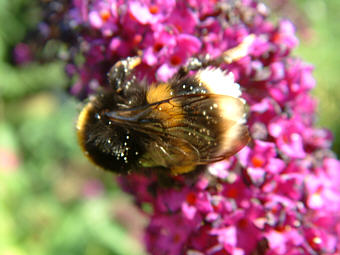 Bombus terrestris
Bombus terrestris
There are now only 23 species of bumblebees to be found in Britain, and so far in Bedfordshire only 16 of these have ever been recorded. One of these, Bombus subterraneus is now believed to be extinct in Britain, but populations introduced to New Zealand towards the end of the nineteenth century still survive there.
Bumble bees are divided up into 2 distinct groups: the true bumblebees and the Cuckoo bumblebees.
The true bumblebees have a queen that usually survives the winter in hibernation, and in the spring searches for suitable nesting sites. Once found (usually underground in an old mouse or vole nest) she will proceed to build brood chambers in order to raise female (unmated) workers. These will eventually take over the duties initially performed by the queen, in foraging and collecting pollen and nectar to supply the growing colony with food.
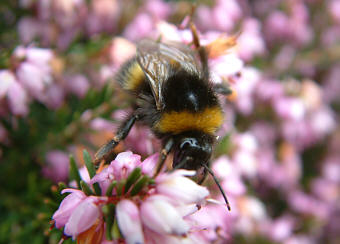 Bombus lucorum
Bombus lucorum
As the season progresses, the queen ceases other activities and concentrates on egg laying. The workers meanwhile either work on nest duties or become foraging workers. The queen may lay up to 100 or more eggs in her lifetime, and will produce batches of unfertilized eggs which become males, or fertilized eggs which become future queens.
Cuckoo bumblebees, such as Bombus vestalis, emerge from hibernation about six weeks after their host bumblebee species, and do not form a nest. Instead they invade and lay their eggs in an already established bumblebee nest. The Cuckoo bumblebee often superficially resembles their host in appearance, and in order to gain entry to the host's nest will either fight with and kill the existing queen, or wait until she acquires the correct scent so she will be accepted by the workers. After this, the Cuckoo female then lays eggs in the host's nest, and then flies off leaving the workers to bring up her offspring. From the host's nest will eventually emerge male and female cuckoo bumblebees, but no workers.
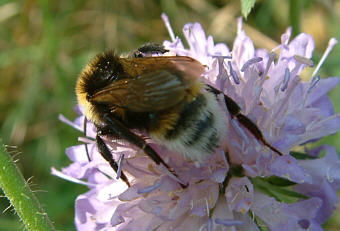 Bombus vestalis
Bombus vestalis
Bumblebees, like many insects, have a number of serious parasites, including roundworms and a conopid fly larvae which lives in the bumblebee for quite a time, and affects the behaviour of the infected insect.
Often bumblebees become infested with very small parasitic mites that live in their tracheae (breathing tubes) which affects the performance of the insect. The larger mites that can be often seen attached to the head and thorax of bumblebees while foraging are not parasites, but act as scavengers in the nest, and are in fact beneficial to the bumblebee colony.
One of the most common species to be found in Britain at present is the Buff-tailed Bumblebee, (Bombus terrestris), and can often be seen in early spring, along with the Early nesting Bumblebee (Bombus pratorum) and the White-tailed Bumblebee (Bombus lucorum).
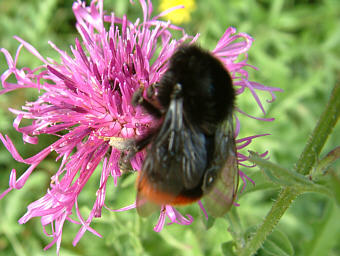 Bombus lapidarius
Bombus lapidarius
In addition to these species can be seen the Garden Bumblebee (Bombus hortorum), the red-tailed bumblebee (Bombus lapidarius) and the Common Carder (Bombus pascuorum). These six species are most likely to be encountered in gardens and throughout the countryside in England, Wales and Scotland, and occasionally Ireland.
Another species which has very recently moved into southern England is Bombus hypnorum, which is very common in Europe, and was first recorded near the village of Landford in Wiltshire on 17th July 2001. This species has now been recorded from south-east England from a number of localities, and will no doubt spread into the rest of Britain in due course. It can be found flying around with B. terrestris, B. lucorum and other common species in parks, gardens and also on heaths and in woodlands.
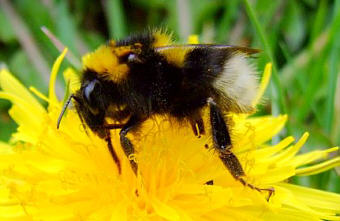 Bombus hortorum © John Pitts
Bombus hortorum © John Pitts
In order to encourage bumblebees into your garden and to help with their conservation, it is important to grow as many wildflowers and garden flowers as possible throughout the year. This is important to maintain a steady supply of pollen and nectar for the growing colony. If you discover a nest, please record this as well as all individual species flying around and if possible what flowers they are visiting.
Bumblebee recording has been neglected in Bedfordshire for many years, and as many records as possible are required. If you come across any dead specimens, please keep these and send to the County Recorder for identification. Also some photos may be of benefit.
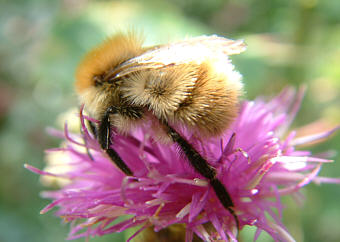 Bombus pascuorum
Bombus pascuorum
Here is a list of plants to grow which will actively encourage bumblebees into your garden:
Heathers, Gorse, Broom, Lungwort, Cowslip, Crocus, Wild Bluebell, Red dead-nettle, white dead-nettle, catmint, Flowering currant, Apple, Plum, Honeysuckle, Foxglove, Bugle, Small scabious, Field scabious, Chives, Borage, Black knapweed, Greater Knapweed, Hawthorn, Blackthorn, Marjorum, Lucerne, Betony, Self-heal, Spear thistle, Marsh thistle, Viper’s Bugloss, Red Clover, White clover, Melilot, Sainfoin, Salvias, Tufted Vetch, Harebell, Clustered Bellflower, Masterwort, Meadow cranesbill, Golden rod, and all composites like Dandelion and Comfrey.